Nursing Case Study
VerifiedAdded on 2022/12/18
|12
|3591
|1
AI Summary
This nursing case study focuses on the condition of Mr. Sam Kwon, a 74-year-old man with right-sided hemiparalysis, aphasia, and facial drooping. The study analyzes his condition, provides a management plan, and discusses the discharge plan. It also explores the ethical and legal implications of his care and emphasizes the importance of person-centered care and health promotion strategies.
Contribute Materials
Your contribution can guide someone’s learning journey. Share your
documents today.

Nursing Case Study
Name of the Student
Name of the University
Author Note
Name of the Student
Name of the University
Author Note
Secure Best Marks with AI Grader
Need help grading? Try our AI Grader for instant feedback on your assignments.
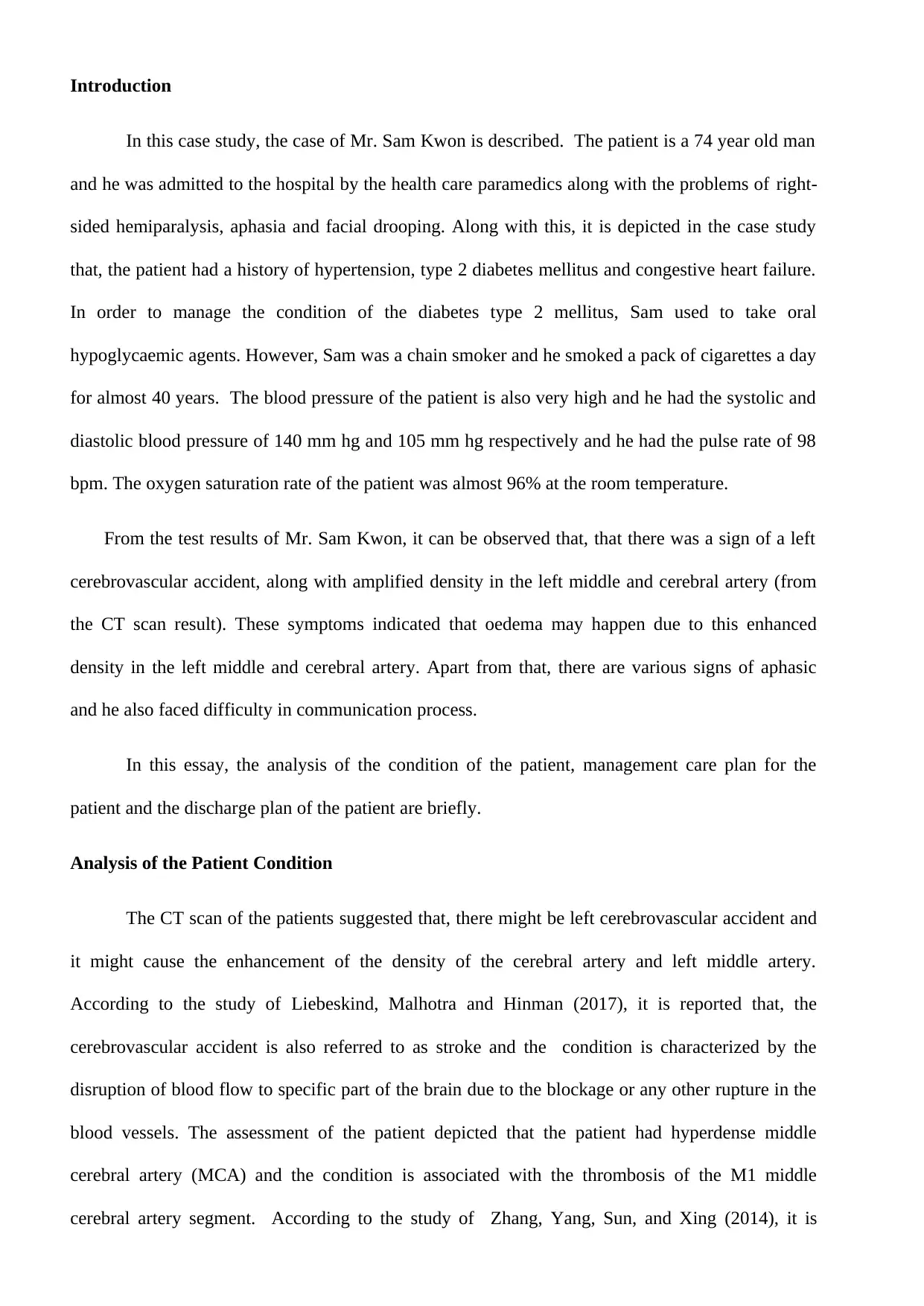
Introduction
In this case study, the case of Mr. Sam Kwon is described. The patient is a 74 year old man
and he was admitted to the hospital by the health care paramedics along with the problems of right-
sided hemiparalysis, aphasia and facial drooping. Along with this, it is depicted in the case study
that, the patient had a history of hypertension, type 2 diabetes mellitus and congestive heart failure.
In order to manage the condition of the diabetes type 2 mellitus, Sam used to take oral
hypoglycaemic agents. However, Sam was a chain smoker and he smoked a pack of cigarettes a day
for almost 40 years. The blood pressure of the patient is also very high and he had the systolic and
diastolic blood pressure of 140 mm hg and 105 mm hg respectively and he had the pulse rate of 98
bpm. The oxygen saturation rate of the patient was almost 96% at the room temperature.
From the test results of Mr. Sam Kwon, it can be observed that, that there was a sign of a left
cerebrovascular accident, along with amplified density in the left middle and cerebral artery (from
the CT scan result). These symptoms indicated that oedema may happen due to this enhanced
density in the left middle and cerebral artery. Apart from that, there are various signs of aphasic
and he also faced difficulty in communication process.
In this essay, the analysis of the condition of the patient, management care plan for the
patient and the discharge plan of the patient are briefly.
Analysis of the Patient Condition
The CT scan of the patients suggested that, there might be left cerebrovascular accident and
it might cause the enhancement of the density of the cerebral artery and left middle artery.
According to the study of Liebeskind, Malhotra and Hinman (2017), it is reported that, the
cerebrovascular accident is also referred to as stroke and the condition is characterized by the
disruption of blood flow to specific part of the brain due to the blockage or any other rupture in the
blood vessels. The assessment of the patient depicted that the patient had hyperdense middle
cerebral artery (MCA) and the condition is associated with the thrombosis of the M1 middle
cerebral artery segment. According to the study of Zhang, Yang, Sun, and Xing (2014), it is
In this case study, the case of Mr. Sam Kwon is described. The patient is a 74 year old man
and he was admitted to the hospital by the health care paramedics along with the problems of right-
sided hemiparalysis, aphasia and facial drooping. Along with this, it is depicted in the case study
that, the patient had a history of hypertension, type 2 diabetes mellitus and congestive heart failure.
In order to manage the condition of the diabetes type 2 mellitus, Sam used to take oral
hypoglycaemic agents. However, Sam was a chain smoker and he smoked a pack of cigarettes a day
for almost 40 years. The blood pressure of the patient is also very high and he had the systolic and
diastolic blood pressure of 140 mm hg and 105 mm hg respectively and he had the pulse rate of 98
bpm. The oxygen saturation rate of the patient was almost 96% at the room temperature.
From the test results of Mr. Sam Kwon, it can be observed that, that there was a sign of a left
cerebrovascular accident, along with amplified density in the left middle and cerebral artery (from
the CT scan result). These symptoms indicated that oedema may happen due to this enhanced
density in the left middle and cerebral artery. Apart from that, there are various signs of aphasic
and he also faced difficulty in communication process.
In this essay, the analysis of the condition of the patient, management care plan for the
patient and the discharge plan of the patient are briefly.
Analysis of the Patient Condition
The CT scan of the patients suggested that, there might be left cerebrovascular accident and
it might cause the enhancement of the density of the cerebral artery and left middle artery.
According to the study of Liebeskind, Malhotra and Hinman (2017), it is reported that, the
cerebrovascular accident is also referred to as stroke and the condition is characterized by the
disruption of blood flow to specific part of the brain due to the blockage or any other rupture in the
blood vessels. The assessment of the patient depicted that the patient had hyperdense middle
cerebral artery (MCA) and the condition is associated with the thrombosis of the M1 middle
cerebral artery segment. According to the study of Zhang, Yang, Sun, and Xing (2014), it is
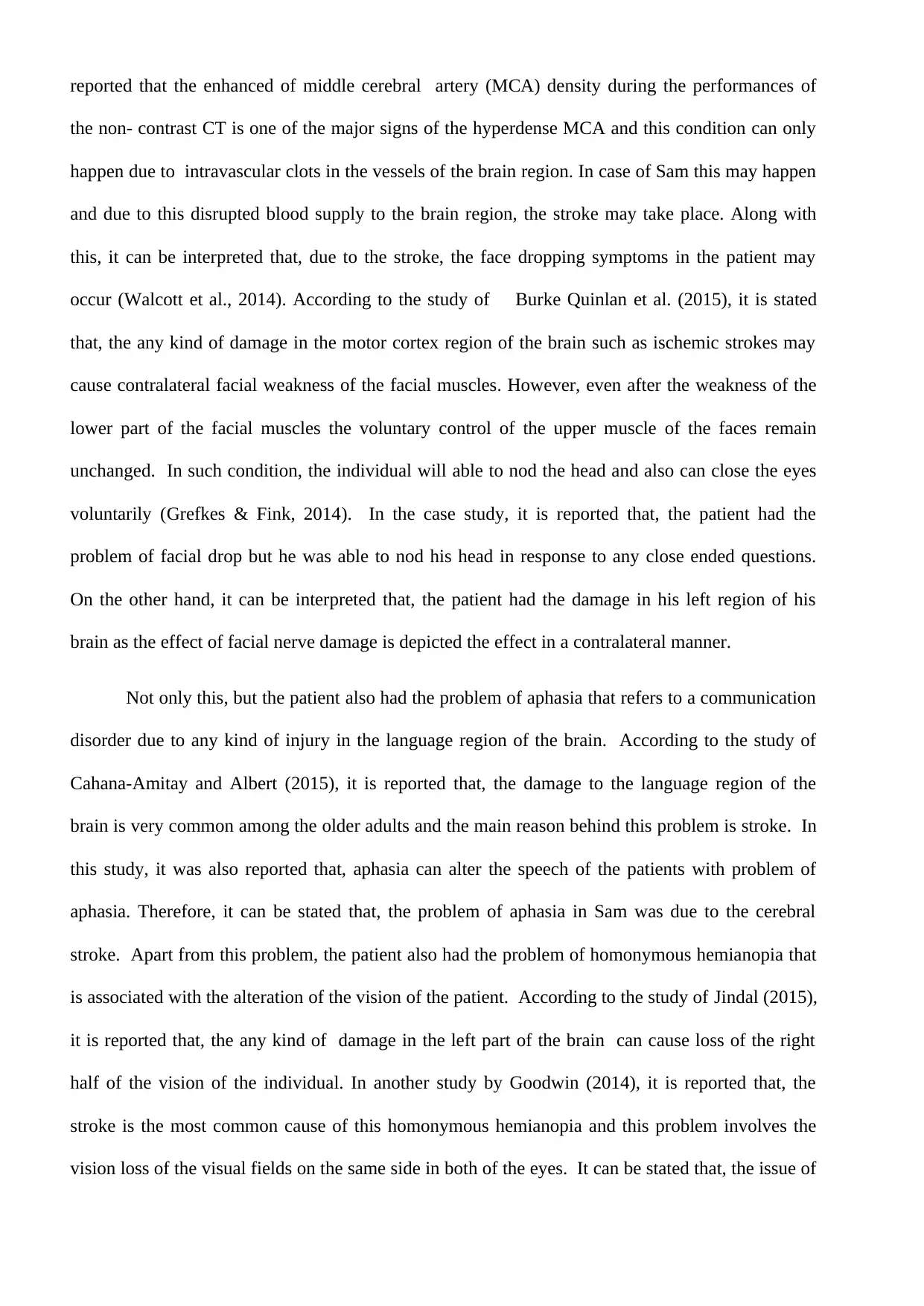
reported that the enhanced of middle cerebral artery (MCA) density during the performances of
the non- contrast CT is one of the major signs of the hyperdense MCA and this condition can only
happen due to intravascular clots in the vessels of the brain region. In case of Sam this may happen
and due to this disrupted blood supply to the brain region, the stroke may take place. Along with
this, it can be interpreted that, due to the stroke, the face dropping symptoms in the patient may
occur (Walcott et al., 2014). According to the study of Burke Quinlan et al. (2015), it is stated
that, the any kind of damage in the motor cortex region of the brain such as ischemic strokes may
cause contralateral facial weakness of the facial muscles. However, even after the weakness of the
lower part of the facial muscles the voluntary control of the upper muscle of the faces remain
unchanged. In such condition, the individual will able to nod the head and also can close the eyes
voluntarily (Grefkes & Fink, 2014). In the case study, it is reported that, the patient had the
problem of facial drop but he was able to nod his head in response to any close ended questions.
On the other hand, it can be interpreted that, the patient had the damage in his left region of his
brain as the effect of facial nerve damage is depicted the effect in a contralateral manner.
Not only this, but the patient also had the problem of aphasia that refers to a communication
disorder due to any kind of injury in the language region of the brain. According to the study of
Cahana-Amitay and Albert (2015), it is reported that, the damage to the language region of the
brain is very common among the older adults and the main reason behind this problem is stroke. In
this study, it was also reported that, aphasia can alter the speech of the patients with problem of
aphasia. Therefore, it can be stated that, the problem of aphasia in Sam was due to the cerebral
stroke. Apart from this problem, the patient also had the problem of homonymous hemianopia that
is associated with the alteration of the vision of the patient. According to the study of Jindal (2015),
it is reported that, the any kind of damage in the left part of the brain can cause loss of the right
half of the vision of the individual. In another study by Goodwin (2014), it is reported that, the
stroke is the most common cause of this homonymous hemianopia and this problem involves the
vision loss of the visual fields on the same side in both of the eyes. It can be stated that, the issue of
the non- contrast CT is one of the major signs of the hyperdense MCA and this condition can only
happen due to intravascular clots in the vessels of the brain region. In case of Sam this may happen
and due to this disrupted blood supply to the brain region, the stroke may take place. Along with
this, it can be interpreted that, due to the stroke, the face dropping symptoms in the patient may
occur (Walcott et al., 2014). According to the study of Burke Quinlan et al. (2015), it is stated
that, the any kind of damage in the motor cortex region of the brain such as ischemic strokes may
cause contralateral facial weakness of the facial muscles. However, even after the weakness of the
lower part of the facial muscles the voluntary control of the upper muscle of the faces remain
unchanged. In such condition, the individual will able to nod the head and also can close the eyes
voluntarily (Grefkes & Fink, 2014). In the case study, it is reported that, the patient had the
problem of facial drop but he was able to nod his head in response to any close ended questions.
On the other hand, it can be interpreted that, the patient had the damage in his left region of his
brain as the effect of facial nerve damage is depicted the effect in a contralateral manner.
Not only this, but the patient also had the problem of aphasia that refers to a communication
disorder due to any kind of injury in the language region of the brain. According to the study of
Cahana-Amitay and Albert (2015), it is reported that, the damage to the language region of the
brain is very common among the older adults and the main reason behind this problem is stroke. In
this study, it was also reported that, aphasia can alter the speech of the patients with problem of
aphasia. Therefore, it can be stated that, the problem of aphasia in Sam was due to the cerebral
stroke. Apart from this problem, the patient also had the problem of homonymous hemianopia that
is associated with the alteration of the vision of the patient. According to the study of Jindal (2015),
it is reported that, the any kind of damage in the left part of the brain can cause loss of the right
half of the vision of the individual. In another study by Goodwin (2014), it is reported that, the
stroke is the most common cause of this homonymous hemianopia and this problem involves the
vision loss of the visual fields on the same side in both of the eyes. It can be stated that, the issue of

vision loss is the sign of lesion in the visual pathway posterior to the chiasm (Philip & Dutton,
2014).
In case of Sam, it is reported that, the individual had right sided hemiparalysis that is the
sign of left brain damage and the homonymous hemianopia is also due to this left brain damage.
Therefore, it can be easily interpreted that, the left side of Sam’s brain was damaged due to the
cerebrovascular stroke. The blood glucose level of the patient is indicating the issue of diabetes
mellitus type 2 and the blood glucose level of the patients is almost 9.4 mmol/L. The patient also
had basal crackles and it is reported that, the cause of crackles is associated with the problem of
accumulation of fluids in the alveoli due to cardiovascular problem (Busl & Bleck, 2015).
In case of Sam, the cerebrovascular problems and crackles may occur in the patient. For
improving this condition in Sam, oxygen therapy was applied. Along with this, in order to remove
the clot from the blood vessels of the patient’s body, crystalloid fluid was delivered through the IV
catheter. According to the study of Chatrath , Khetarpal and Ahuja (2015), it is reported that, in
order to enhance the intravascular volume of the body fluids, the application of the crystalloid fluids
are very effective. The study also reported that, reduction in body fluids may happen due to the
haemorrhage in the blood vessels of the body and thereby reduce the overall volume of the body
fluids. In this case study, Sam had the problem of blood clot in the blood vessels of the brain region
and thus it is very crucial to enhance the body fluids of the patient. For this reason, Sam had been
given the crystalloid fluid as a part of the medication (Reddy, Weinberg, & Young, 2015).
Interprofessional Care and Management Plan
Based on the analysis of the case study of Sam, it is reported that, the patient had the
problems in respiration, problem of diabetes mellitus type 2, right side hemiparalysis, and
homonymous hemianopia. For the aforesaid problems, in the management team of the patient, there
must be a physiotherapist, a nutritionist, occupational therapist counsellor, eye specialists and
neurologist, speech therapist in the interdisciplinary team of the patient (Bhogal et al., 2017). In the
inter discipline team for managing the condition of the patient, the neurologist will try to address
2014).
In case of Sam, it is reported that, the individual had right sided hemiparalysis that is the
sign of left brain damage and the homonymous hemianopia is also due to this left brain damage.
Therefore, it can be easily interpreted that, the left side of Sam’s brain was damaged due to the
cerebrovascular stroke. The blood glucose level of the patient is indicating the issue of diabetes
mellitus type 2 and the blood glucose level of the patients is almost 9.4 mmol/L. The patient also
had basal crackles and it is reported that, the cause of crackles is associated with the problem of
accumulation of fluids in the alveoli due to cardiovascular problem (Busl & Bleck, 2015).
In case of Sam, the cerebrovascular problems and crackles may occur in the patient. For
improving this condition in Sam, oxygen therapy was applied. Along with this, in order to remove
the clot from the blood vessels of the patient’s body, crystalloid fluid was delivered through the IV
catheter. According to the study of Chatrath , Khetarpal and Ahuja (2015), it is reported that, in
order to enhance the intravascular volume of the body fluids, the application of the crystalloid fluids
are very effective. The study also reported that, reduction in body fluids may happen due to the
haemorrhage in the blood vessels of the body and thereby reduce the overall volume of the body
fluids. In this case study, Sam had the problem of blood clot in the blood vessels of the brain region
and thus it is very crucial to enhance the body fluids of the patient. For this reason, Sam had been
given the crystalloid fluid as a part of the medication (Reddy, Weinberg, & Young, 2015).
Interprofessional Care and Management Plan
Based on the analysis of the case study of Sam, it is reported that, the patient had the
problems in respiration, problem of diabetes mellitus type 2, right side hemiparalysis, and
homonymous hemianopia. For the aforesaid problems, in the management team of the patient, there
must be a physiotherapist, a nutritionist, occupational therapist counsellor, eye specialists and
neurologist, speech therapist in the interdisciplinary team of the patient (Bhogal et al., 2017). In the
inter discipline team for managing the condition of the patient, the neurologist will try to address
Secure Best Marks with AI Grader
Need help grading? Try our AI Grader for instant feedback on your assignments.

the problem of hyperdense MCA and on the other hand, the physiotherapist will help the patient in
the improving the movements of the body part of the patient. As Sam had right sided hemiparalysis,
so the improvement of bodily movement of Sam is very crucial. On the other hand, the occupational
therapist present in the multidisciplinary team will help the patient in walking by providing
appropriate exercises. Along with this, an occupational therapist can also help the patient in
improvement of breathing and in this case the presence of occupation therapist is very crucial as the
patient had problem in breathing (due to presence of crackles) and walking as well (due to the
hemiparalysis) (van Duijnhoven et al., 2016). According to the study of Brady, Kelly, Godwin,
Enderby and Campbell (2015), it is reported that, a speech therapist can help the patient in the
improvement of speech and in this case, Sam had serious problem in his talking due to face
drooping. So, a speech therapist can help the person in the restoration of the speech of that person.
In this case scenario, Sam had aphasic and due to this only a speech therapist can help him in this
problem. Therefore, the counsellor will help Sam to improve the smoking behaviour as smoking is
one of the promoting factors of cardiovascular disease and lung fibrosis. According to the study of
Busl and Bleck (2015), it is reported that, lung fibrosis can promote the issue of crackles in the
lungs. In this case study, it is reported that, Sam was a regular smoker and so a counsellor can help
him in the cessation of smoking as well.
Ethical and legal implications
During providing care to the patient the all the nurses and the care providers present in the
multidisciplinary team must follow the ethical issues regarding the delivery of care to the patients.
From the point of views of the health care professionals, it can be stated that in some cases, it is
very difficult to maintain the ethical considerations such as truth telling and nonmaleficence
behaviour of the patients. Along With this, the health care providers must maintain the balance in
between the patient’ needs and along with this, all the health care professional must consider the
issue of patient’s autonomy as well. Moreover, as the patient is unable to take decisions due to his
condition, there are chances of breaching of ethical issues. In case of legal considerations, the health
the improving the movements of the body part of the patient. As Sam had right sided hemiparalysis,
so the improvement of bodily movement of Sam is very crucial. On the other hand, the occupational
therapist present in the multidisciplinary team will help the patient in walking by providing
appropriate exercises. Along with this, an occupational therapist can also help the patient in
improvement of breathing and in this case the presence of occupation therapist is very crucial as the
patient had problem in breathing (due to presence of crackles) and walking as well (due to the
hemiparalysis) (van Duijnhoven et al., 2016). According to the study of Brady, Kelly, Godwin,
Enderby and Campbell (2015), it is reported that, a speech therapist can help the patient in the
improvement of speech and in this case, Sam had serious problem in his talking due to face
drooping. So, a speech therapist can help the person in the restoration of the speech of that person.
In this case scenario, Sam had aphasic and due to this only a speech therapist can help him in this
problem. Therefore, the counsellor will help Sam to improve the smoking behaviour as smoking is
one of the promoting factors of cardiovascular disease and lung fibrosis. According to the study of
Busl and Bleck (2015), it is reported that, lung fibrosis can promote the issue of crackles in the
lungs. In this case study, it is reported that, Sam was a regular smoker and so a counsellor can help
him in the cessation of smoking as well.
Ethical and legal implications
During providing care to the patient the all the nurses and the care providers present in the
multidisciplinary team must follow the ethical issues regarding the delivery of care to the patients.
From the point of views of the health care professionals, it can be stated that in some cases, it is
very difficult to maintain the ethical considerations such as truth telling and nonmaleficence
behaviour of the patients. Along With this, the health care providers must maintain the balance in
between the patient’ needs and along with this, all the health care professional must consider the
issue of patient’s autonomy as well. Moreover, as the patient is unable to take decisions due to his
condition, there are chances of breaching of ethical issues. In case of legal considerations, the health
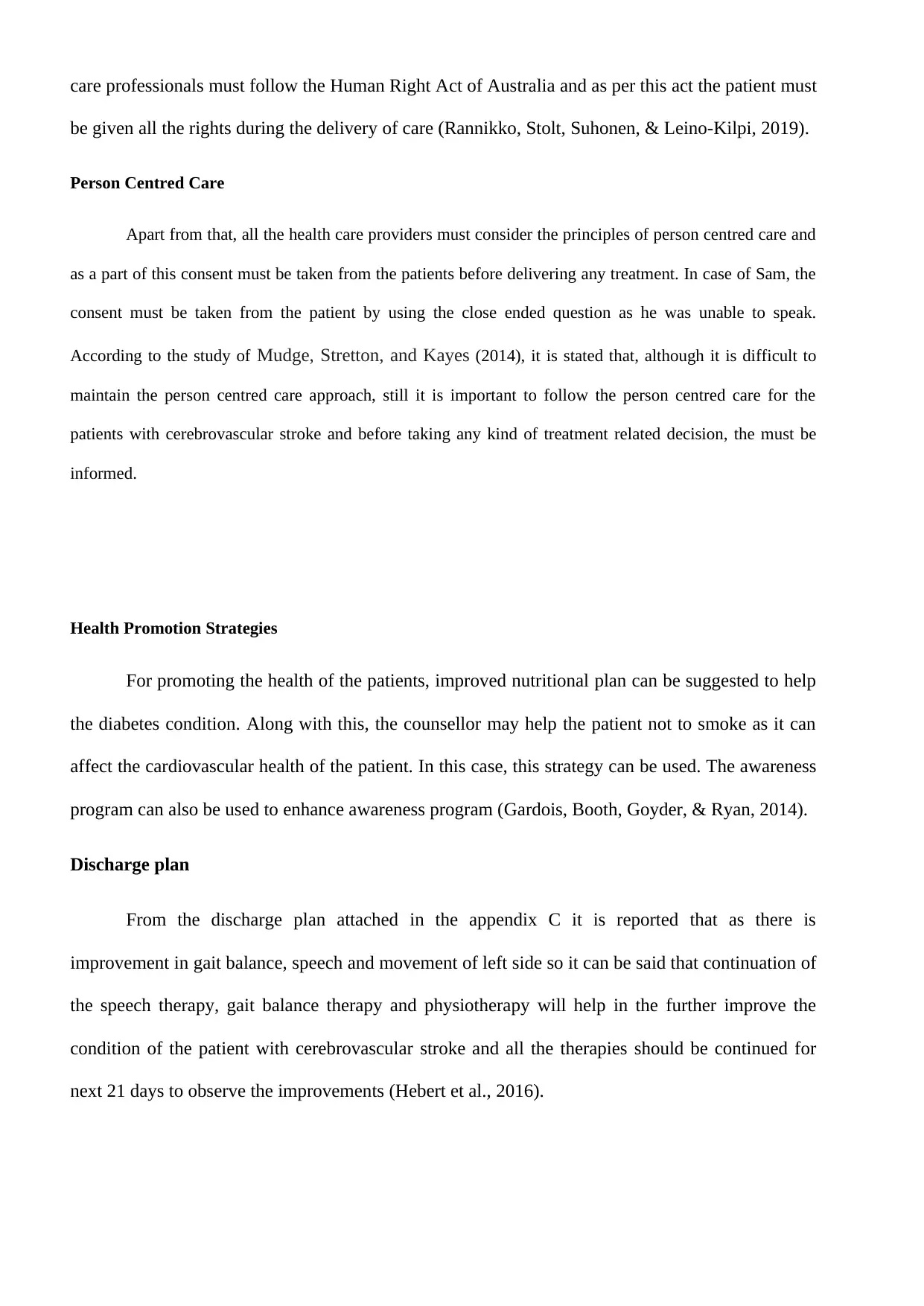
care professionals must follow the Human Right Act of Australia and as per this act the patient must
be given all the rights during the delivery of care (Rannikko, Stolt, Suhonen, & Leino‐Kilpi, 2019).
Person Centred Care
Apart from that, all the health care providers must consider the principles of person centred care and
as a part of this consent must be taken from the patients before delivering any treatment. In case of Sam, the
consent must be taken from the patient by using the close ended question as he was unable to speak.
According to the study of Mudge, Stretton, and Kayes (2014), it is stated that, although it is difficult to
maintain the person centred care approach, still it is important to follow the person centred care for the
patients with cerebrovascular stroke and before taking any kind of treatment related decision, the must be
informed.
Health Promotion Strategies
For promoting the health of the patients, improved nutritional plan can be suggested to help
the diabetes condition. Along with this, the counsellor may help the patient not to smoke as it can
affect the cardiovascular health of the patient. In this case, this strategy can be used. The awareness
program can also be used to enhance awareness program (Gardois, Booth, Goyder, & Ryan, 2014).
Discharge plan
From the discharge plan attached in the appendix C it is reported that as there is
improvement in gait balance, speech and movement of left side so it can be said that continuation of
the speech therapy, gait balance therapy and physiotherapy will help in the further improve the
condition of the patient with cerebrovascular stroke and all the therapies should be continued for
next 21 days to observe the improvements (Hebert et al., 2016).
be given all the rights during the delivery of care (Rannikko, Stolt, Suhonen, & Leino‐Kilpi, 2019).
Person Centred Care
Apart from that, all the health care providers must consider the principles of person centred care and
as a part of this consent must be taken from the patients before delivering any treatment. In case of Sam, the
consent must be taken from the patient by using the close ended question as he was unable to speak.
According to the study of Mudge, Stretton, and Kayes (2014), it is stated that, although it is difficult to
maintain the person centred care approach, still it is important to follow the person centred care for the
patients with cerebrovascular stroke and before taking any kind of treatment related decision, the must be
informed.
Health Promotion Strategies
For promoting the health of the patients, improved nutritional plan can be suggested to help
the diabetes condition. Along with this, the counsellor may help the patient not to smoke as it can
affect the cardiovascular health of the patient. In this case, this strategy can be used. The awareness
program can also be used to enhance awareness program (Gardois, Booth, Goyder, & Ryan, 2014).
Discharge plan
From the discharge plan attached in the appendix C it is reported that as there is
improvement in gait balance, speech and movement of left side so it can be said that continuation of
the speech therapy, gait balance therapy and physiotherapy will help in the further improve the
condition of the patient with cerebrovascular stroke and all the therapies should be continued for
next 21 days to observe the improvements (Hebert et al., 2016).
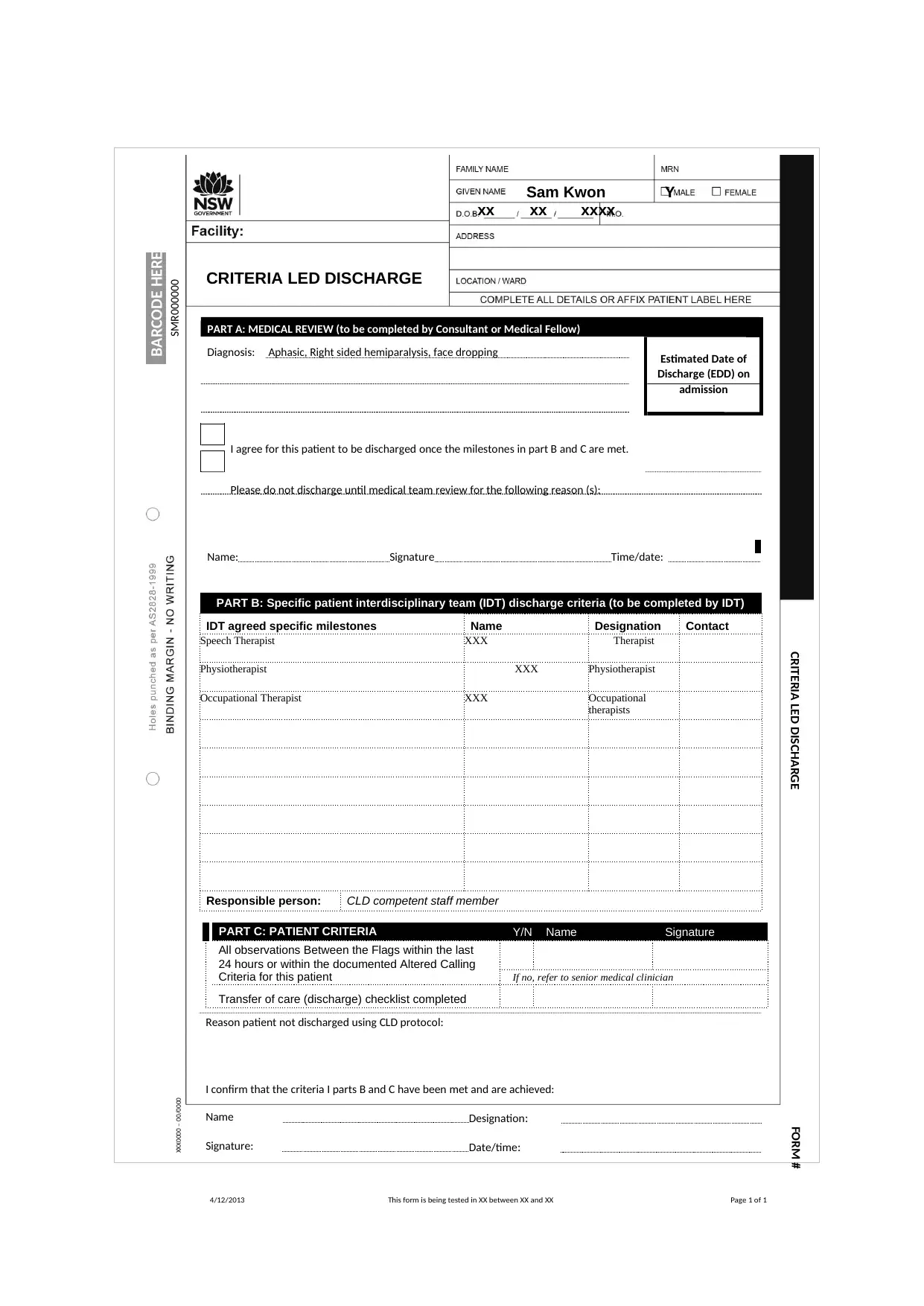
Sam Kwon Y
xx xx xxxx
CRITERIA LED DISCHARGE
Diagnosis: Aphasic, Right sided hemiparalysis, face dropping
I agree for this patient to be discharged once the milestones in part B and C are met.
Please do not discharge until medical team review for the following reason (s):
Name: Signature Time/date:
PART B: Specific patient interdisciplinary team (IDT) discharge criteria (to be completed by IDT)
IDT agreed specific milestones Name Designation Contact
Speech Therapist XXX Therapist
Physiotherapist XXX Physiotherapist
Occupational Therapist XXX Occupational
therapists
Responsible person: CLD competent staff member
PART C: PATIENT CRITERIA Y/N Name Signature
All observations Between the Flags within the last
24 hours or within the documented Altered Calling
Criteria for this patient If no, refer to senior medical clinician
Transfer of care (discharge) checklist completed
Reason patient not discharged using CLD protocol:
I confirm that the criteria I parts B and C have been met and are achieved:
Name Designation:
Signature: Date/time:
4/12/2013 This form is being tested in XX between XX and XX Page 1 of 1
PART A: MEDICAL REVIEW (to be completed by Consultant or Medical Fellow)
Estimated Date of
Discharge (EDD) on
admission
CRITERIA LED DISCHARGE FORM #
BARCODE HERE
SMR000000XXX0000 – 00/0000
xx xx xxxx
CRITERIA LED DISCHARGE
Diagnosis: Aphasic, Right sided hemiparalysis, face dropping
I agree for this patient to be discharged once the milestones in part B and C are met.
Please do not discharge until medical team review for the following reason (s):
Name: Signature Time/date:
PART B: Specific patient interdisciplinary team (IDT) discharge criteria (to be completed by IDT)
IDT agreed specific milestones Name Designation Contact
Speech Therapist XXX Therapist
Physiotherapist XXX Physiotherapist
Occupational Therapist XXX Occupational
therapists
Responsible person: CLD competent staff member
PART C: PATIENT CRITERIA Y/N Name Signature
All observations Between the Flags within the last
24 hours or within the documented Altered Calling
Criteria for this patient If no, refer to senior medical clinician
Transfer of care (discharge) checklist completed
Reason patient not discharged using CLD protocol:
I confirm that the criteria I parts B and C have been met and are achieved:
Name Designation:
Signature: Date/time:
4/12/2013 This form is being tested in XX between XX and XX Page 1 of 1
PART A: MEDICAL REVIEW (to be completed by Consultant or Medical Fellow)
Estimated Date of
Discharge (EDD) on
admission
CRITERIA LED DISCHARGE FORM #
BARCODE HERE
SMR000000XXX0000 – 00/0000
Paraphrase This Document
Need a fresh take? Get an instant paraphrase of this document with our AI Paraphraser
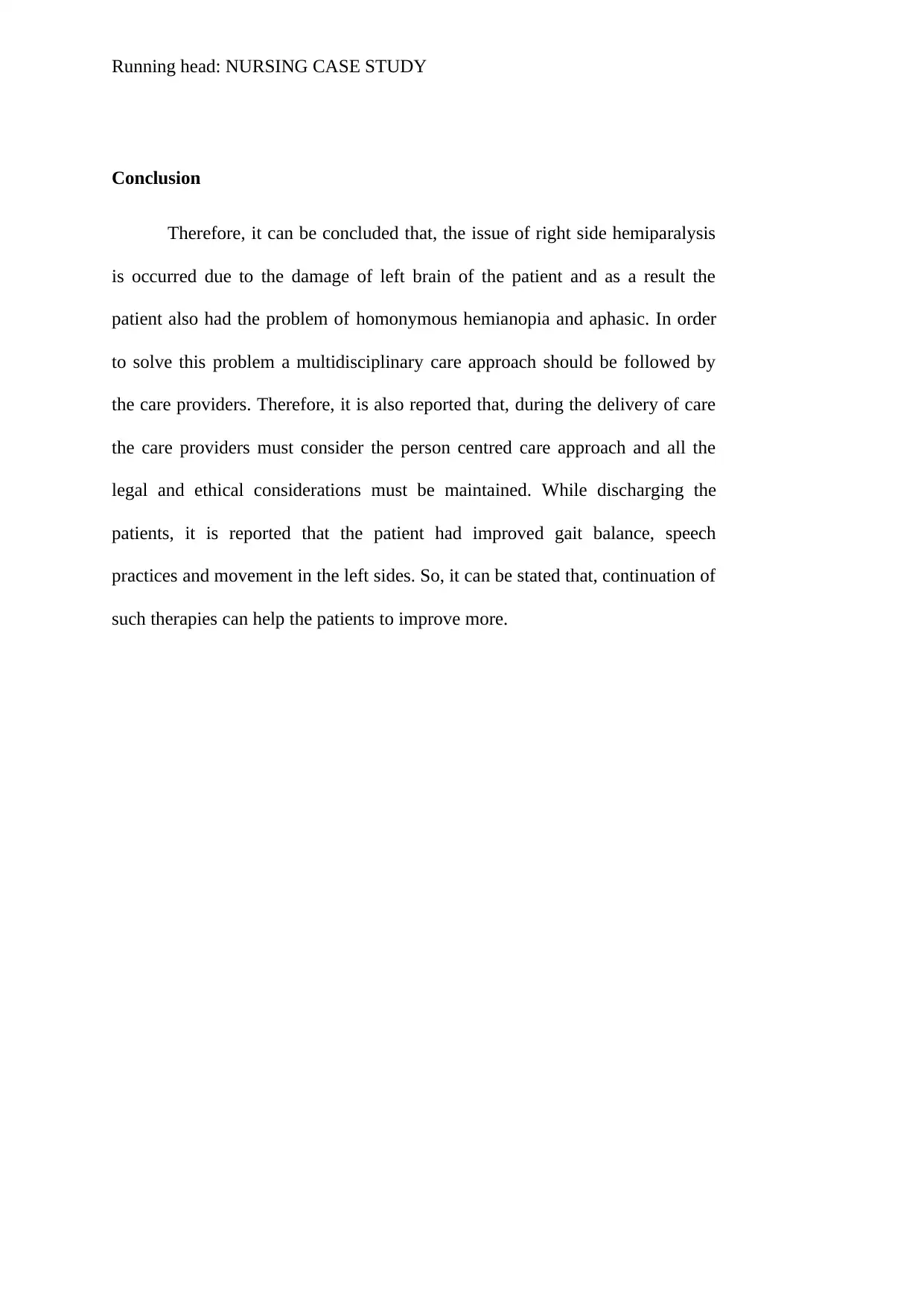
Running head: NURSING CASE STUDY
Conclusion
Therefore, it can be concluded that, the issue of right side hemiparalysis
is occurred due to the damage of left brain of the patient and as a result the
patient also had the problem of homonymous hemianopia and aphasic. In order
to solve this problem a multidisciplinary care approach should be followed by
the care providers. Therefore, it is also reported that, during the delivery of care
the care providers must consider the person centred care approach and all the
legal and ethical considerations must be maintained. While discharging the
patients, it is reported that the patient had improved gait balance, speech
practices and movement in the left sides. So, it can be stated that, continuation of
such therapies can help the patients to improve more.
Conclusion
Therefore, it can be concluded that, the issue of right side hemiparalysis
is occurred due to the damage of left brain of the patient and as a result the
patient also had the problem of homonymous hemianopia and aphasic. In order
to solve this problem a multidisciplinary care approach should be followed by
the care providers. Therefore, it is also reported that, during the delivery of care
the care providers must consider the person centred care approach and all the
legal and ethical considerations must be maintained. While discharging the
patients, it is reported that the patient had improved gait balance, speech
practices and movement in the left sides. So, it can be stated that, continuation of
such therapies can help the patients to improve more.
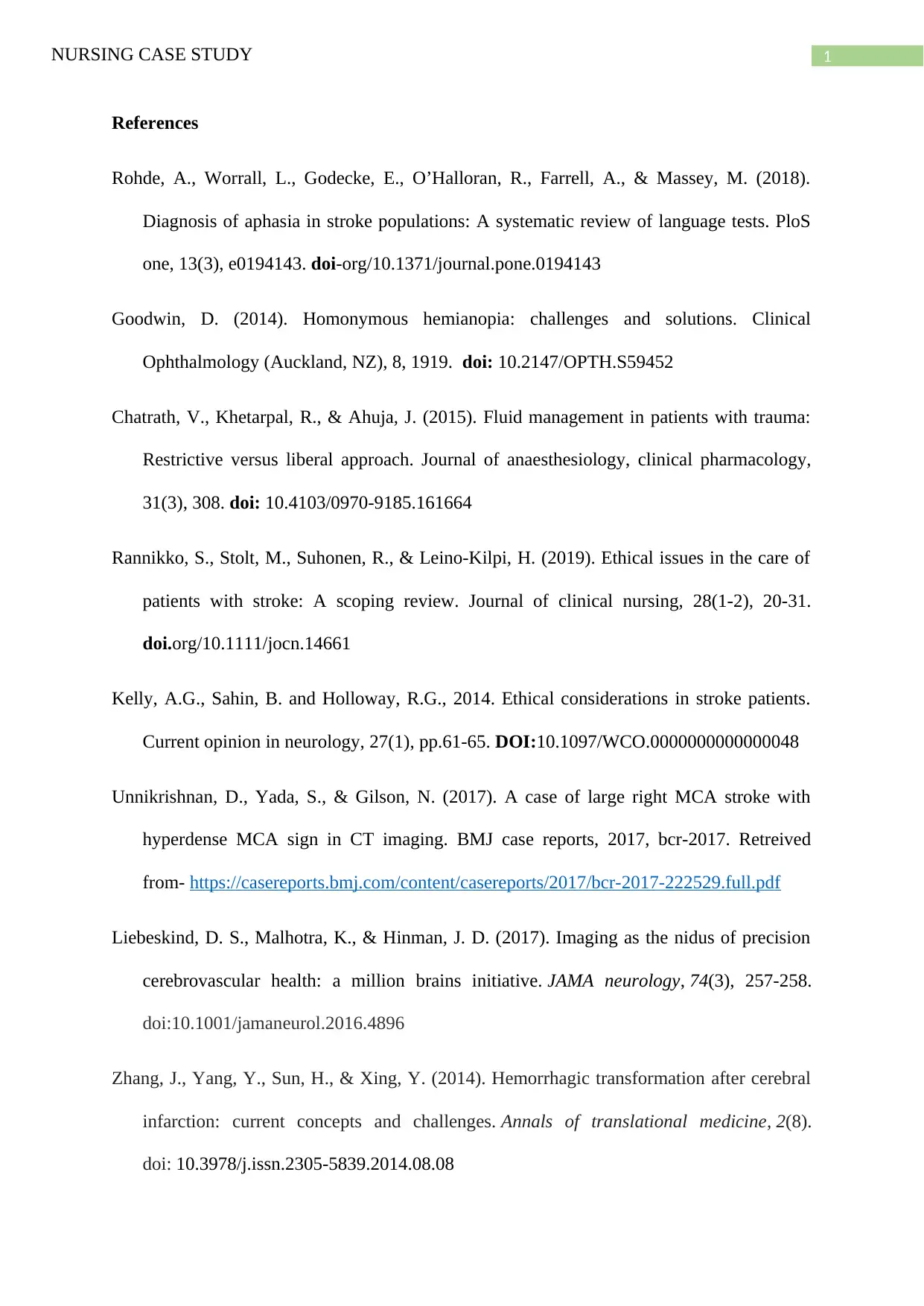
1NURSING CASE STUDY
References
Rohde, A., Worrall, L., Godecke, E., O’Halloran, R., Farrell, A., & Massey, M. (2018).
Diagnosis of aphasia in stroke populations: A systematic review of language tests. PloS
one, 13(3), e0194143. doi-org/10.1371/journal.pone.0194143
Goodwin, D. (2014). Homonymous hemianopia: challenges and solutions. Clinical
Ophthalmology (Auckland, NZ), 8, 1919. doi: 10.2147/OPTH.S59452
Chatrath, V., Khetarpal, R., & Ahuja, J. (2015). Fluid management in patients with trauma:
Restrictive versus liberal approach. Journal of anaesthesiology, clinical pharmacology,
31(3), 308. doi: 10.4103/0970-9185.161664
Rannikko, S., Stolt, M., Suhonen, R., & Leino‐Kilpi, H. (2019). Ethical issues in the care of
patients with stroke: A scoping review. Journal of clinical nursing, 28(1-2), 20-31.
doi.org/10.1111/jocn.14661
Kelly, A.G., Sahin, B. and Holloway, R.G., 2014. Ethical considerations in stroke patients.
Current opinion in neurology, 27(1), pp.61-65. DOI:10.1097/WCO.0000000000000048
Unnikrishnan, D., Yada, S., & Gilson, N. (2017). A case of large right MCA stroke with
hyperdense MCA sign in CT imaging. BMJ case reports, 2017, bcr-2017. Retreived
from- https://casereports.bmj.com/content/casereports/2017/bcr-2017-222529.full.pdf
Liebeskind, D. S., Malhotra, K., & Hinman, J. D. (2017). Imaging as the nidus of precision
cerebrovascular health: a million brains initiative. JAMA neurology, 74(3), 257-258.
doi:10.1001/jamaneurol.2016.4896
Zhang, J., Yang, Y., Sun, H., & Xing, Y. (2014). Hemorrhagic transformation after cerebral
infarction: current concepts and challenges. Annals of translational medicine, 2(8).
doi: 10.3978/j.issn.2305-5839.2014.08.08
References
Rohde, A., Worrall, L., Godecke, E., O’Halloran, R., Farrell, A., & Massey, M. (2018).
Diagnosis of aphasia in stroke populations: A systematic review of language tests. PloS
one, 13(3), e0194143. doi-org/10.1371/journal.pone.0194143
Goodwin, D. (2014). Homonymous hemianopia: challenges and solutions. Clinical
Ophthalmology (Auckland, NZ), 8, 1919. doi: 10.2147/OPTH.S59452
Chatrath, V., Khetarpal, R., & Ahuja, J. (2015). Fluid management in patients with trauma:
Restrictive versus liberal approach. Journal of anaesthesiology, clinical pharmacology,
31(3), 308. doi: 10.4103/0970-9185.161664
Rannikko, S., Stolt, M., Suhonen, R., & Leino‐Kilpi, H. (2019). Ethical issues in the care of
patients with stroke: A scoping review. Journal of clinical nursing, 28(1-2), 20-31.
doi.org/10.1111/jocn.14661
Kelly, A.G., Sahin, B. and Holloway, R.G., 2014. Ethical considerations in stroke patients.
Current opinion in neurology, 27(1), pp.61-65. DOI:10.1097/WCO.0000000000000048
Unnikrishnan, D., Yada, S., & Gilson, N. (2017). A case of large right MCA stroke with
hyperdense MCA sign in CT imaging. BMJ case reports, 2017, bcr-2017. Retreived
from- https://casereports.bmj.com/content/casereports/2017/bcr-2017-222529.full.pdf
Liebeskind, D. S., Malhotra, K., & Hinman, J. D. (2017). Imaging as the nidus of precision
cerebrovascular health: a million brains initiative. JAMA neurology, 74(3), 257-258.
doi:10.1001/jamaneurol.2016.4896
Zhang, J., Yang, Y., Sun, H., & Xing, Y. (2014). Hemorrhagic transformation after cerebral
infarction: current concepts and challenges. Annals of translational medicine, 2(8).
doi: 10.3978/j.issn.2305-5839.2014.08.08
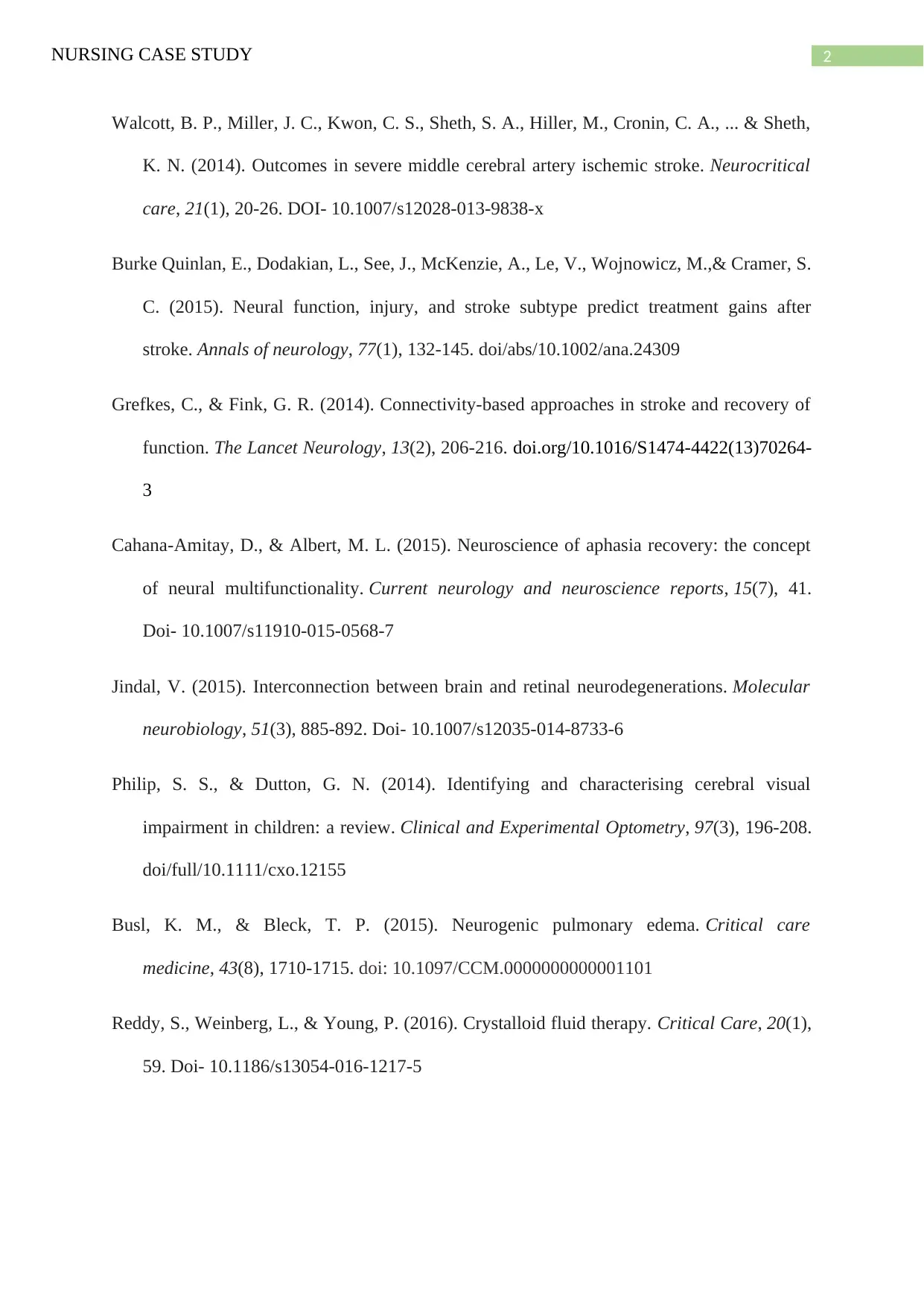
2NURSING CASE STUDY
Walcott, B. P., Miller, J. C., Kwon, C. S., Sheth, S. A., Hiller, M., Cronin, C. A., ... & Sheth,
K. N. (2014). Outcomes in severe middle cerebral artery ischemic stroke. Neurocritical
care, 21(1), 20-26. DOI- 10.1007/s12028-013-9838-x
Burke Quinlan, E., Dodakian, L., See, J., McKenzie, A., Le, V., Wojnowicz, M.,& Cramer, S.
C. (2015). Neural function, injury, and stroke subtype predict treatment gains after
stroke. Annals of neurology, 77(1), 132-145. doi/abs/10.1002/ana.24309
Grefkes, C., & Fink, G. R. (2014). Connectivity-based approaches in stroke and recovery of
function. The Lancet Neurology, 13(2), 206-216. doi.org/10.1016/S1474-4422(13)70264-
3
Cahana-Amitay, D., & Albert, M. L. (2015). Neuroscience of aphasia recovery: the concept
of neural multifunctionality. Current neurology and neuroscience reports, 15(7), 41.
Doi- 10.1007/s11910-015-0568-7
Jindal, V. (2015). Interconnection between brain and retinal neurodegenerations. Molecular
neurobiology, 51(3), 885-892. Doi- 10.1007/s12035-014-8733-6
Philip, S. S., & Dutton, G. N. (2014). Identifying and characterising cerebral visual
impairment in children: a review. Clinical and Experimental Optometry, 97(3), 196-208.
doi/full/10.1111/cxo.12155
Busl, K. M., & Bleck, T. P. (2015). Neurogenic pulmonary edema. Critical care
medicine, 43(8), 1710-1715. doi: 10.1097/CCM.0000000000001101
Reddy, S., Weinberg, L., & Young, P. (2016). Crystalloid fluid therapy. Critical Care, 20(1),
59. Doi- 10.1186/s13054-016-1217-5
Walcott, B. P., Miller, J. C., Kwon, C. S., Sheth, S. A., Hiller, M., Cronin, C. A., ... & Sheth,
K. N. (2014). Outcomes in severe middle cerebral artery ischemic stroke. Neurocritical
care, 21(1), 20-26. DOI- 10.1007/s12028-013-9838-x
Burke Quinlan, E., Dodakian, L., See, J., McKenzie, A., Le, V., Wojnowicz, M.,& Cramer, S.
C. (2015). Neural function, injury, and stroke subtype predict treatment gains after
stroke. Annals of neurology, 77(1), 132-145. doi/abs/10.1002/ana.24309
Grefkes, C., & Fink, G. R. (2014). Connectivity-based approaches in stroke and recovery of
function. The Lancet Neurology, 13(2), 206-216. doi.org/10.1016/S1474-4422(13)70264-
3
Cahana-Amitay, D., & Albert, M. L. (2015). Neuroscience of aphasia recovery: the concept
of neural multifunctionality. Current neurology and neuroscience reports, 15(7), 41.
Doi- 10.1007/s11910-015-0568-7
Jindal, V. (2015). Interconnection between brain and retinal neurodegenerations. Molecular
neurobiology, 51(3), 885-892. Doi- 10.1007/s12035-014-8733-6
Philip, S. S., & Dutton, G. N. (2014). Identifying and characterising cerebral visual
impairment in children: a review. Clinical and Experimental Optometry, 97(3), 196-208.
doi/full/10.1111/cxo.12155
Busl, K. M., & Bleck, T. P. (2015). Neurogenic pulmonary edema. Critical care
medicine, 43(8), 1710-1715. doi: 10.1097/CCM.0000000000001101
Reddy, S., Weinberg, L., & Young, P. (2016). Crystalloid fluid therapy. Critical Care, 20(1),
59. Doi- 10.1186/s13054-016-1217-5
Secure Best Marks with AI Grader
Need help grading? Try our AI Grader for instant feedback on your assignments.
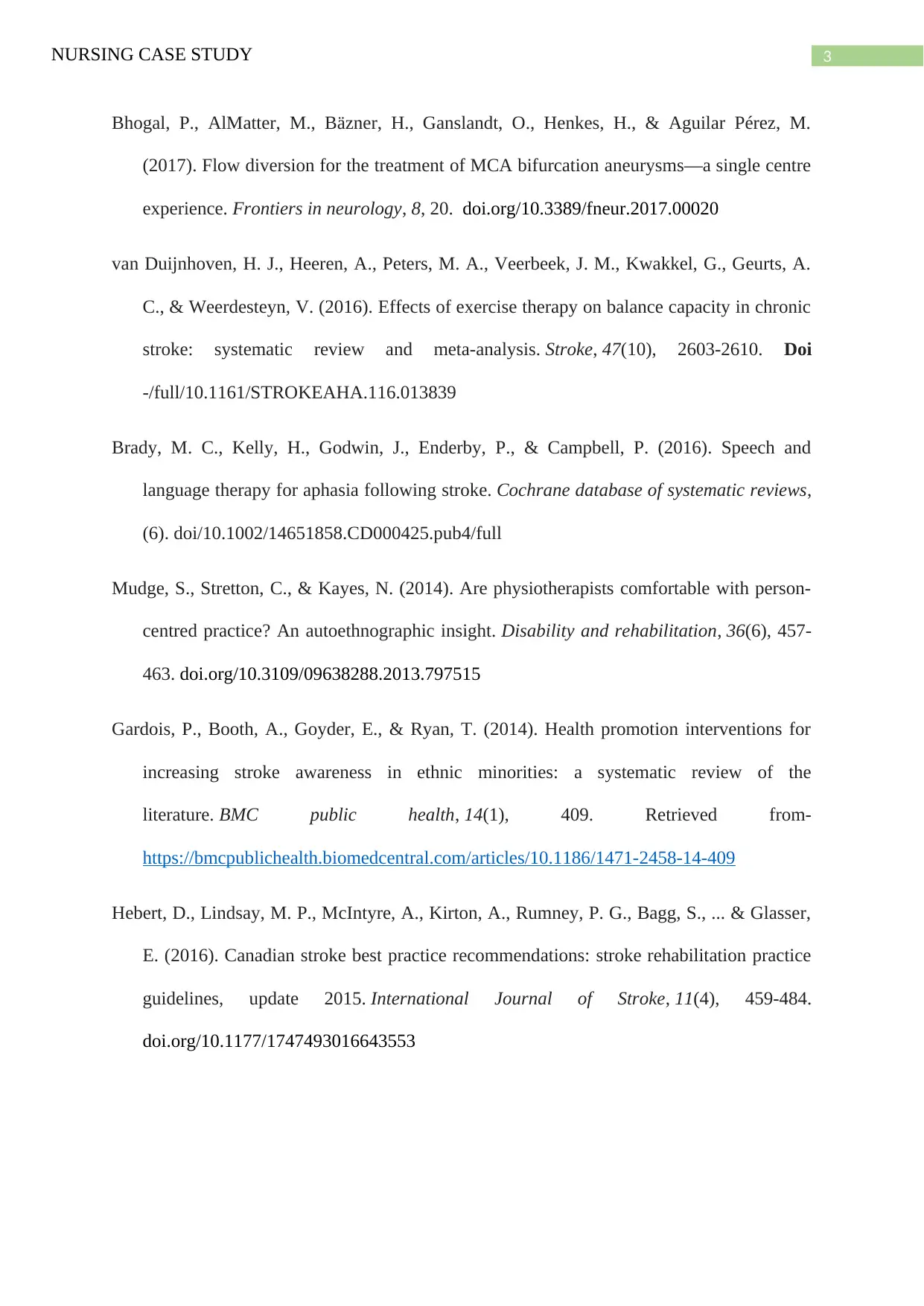
3NURSING CASE STUDY
Bhogal, P., AlMatter, M., Bäzner, H., Ganslandt, O., Henkes, H., & Aguilar Pérez, M.
(2017). Flow diversion for the treatment of MCA bifurcation aneurysms—a single centre
experience. Frontiers in neurology, 8, 20. doi.org/10.3389/fneur.2017.00020
van Duijnhoven, H. J., Heeren, A., Peters, M. A., Veerbeek, J. M., Kwakkel, G., Geurts, A.
C., & Weerdesteyn, V. (2016). Effects of exercise therapy on balance capacity in chronic
stroke: systematic review and meta-analysis. Stroke, 47(10), 2603-2610. Doi
-/full/10.1161/STROKEAHA.116.013839
Brady, M. C., Kelly, H., Godwin, J., Enderby, P., & Campbell, P. (2016). Speech and
language therapy for aphasia following stroke. Cochrane database of systematic reviews,
(6). doi/10.1002/14651858.CD000425.pub4/full
Mudge, S., Stretton, C., & Kayes, N. (2014). Are physiotherapists comfortable with person-
centred practice? An autoethnographic insight. Disability and rehabilitation, 36(6), 457-
463. doi.org/10.3109/09638288.2013.797515
Gardois, P., Booth, A., Goyder, E., & Ryan, T. (2014). Health promotion interventions for
increasing stroke awareness in ethnic minorities: a systematic review of the
literature. BMC public health, 14(1), 409. Retrieved from-
https://bmcpublichealth.biomedcentral.com/articles/10.1186/1471-2458-14-409
Hebert, D., Lindsay, M. P., McIntyre, A., Kirton, A., Rumney, P. G., Bagg, S., ... & Glasser,
E. (2016). Canadian stroke best practice recommendations: stroke rehabilitation practice
guidelines, update 2015. International Journal of Stroke, 11(4), 459-484.
doi.org/10.1177/1747493016643553
Bhogal, P., AlMatter, M., Bäzner, H., Ganslandt, O., Henkes, H., & Aguilar Pérez, M.
(2017). Flow diversion for the treatment of MCA bifurcation aneurysms—a single centre
experience. Frontiers in neurology, 8, 20. doi.org/10.3389/fneur.2017.00020
van Duijnhoven, H. J., Heeren, A., Peters, M. A., Veerbeek, J. M., Kwakkel, G., Geurts, A.
C., & Weerdesteyn, V. (2016). Effects of exercise therapy on balance capacity in chronic
stroke: systematic review and meta-analysis. Stroke, 47(10), 2603-2610. Doi
-/full/10.1161/STROKEAHA.116.013839
Brady, M. C., Kelly, H., Godwin, J., Enderby, P., & Campbell, P. (2016). Speech and
language therapy for aphasia following stroke. Cochrane database of systematic reviews,
(6). doi/10.1002/14651858.CD000425.pub4/full
Mudge, S., Stretton, C., & Kayes, N. (2014). Are physiotherapists comfortable with person-
centred practice? An autoethnographic insight. Disability and rehabilitation, 36(6), 457-
463. doi.org/10.3109/09638288.2013.797515
Gardois, P., Booth, A., Goyder, E., & Ryan, T. (2014). Health promotion interventions for
increasing stroke awareness in ethnic minorities: a systematic review of the
literature. BMC public health, 14(1), 409. Retrieved from-
https://bmcpublichealth.biomedcentral.com/articles/10.1186/1471-2458-14-409
Hebert, D., Lindsay, M. P., McIntyre, A., Kirton, A., Rumney, P. G., Bagg, S., ... & Glasser,
E. (2016). Canadian stroke best practice recommendations: stroke rehabilitation practice
guidelines, update 2015. International Journal of Stroke, 11(4), 459-484.
doi.org/10.1177/1747493016643553

4NURSING CASE STUDY
1 out of 12
Related Documents
Your All-in-One AI-Powered Toolkit for Academic Success.
+13062052269
info@desklib.com
Available 24*7 on WhatsApp / Email
![[object Object]](/_next/static/media/star-bottom.7253800d.svg)
Unlock your academic potential
© 2024 | Zucol Services PVT LTD | All rights reserved.




